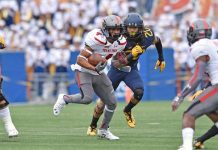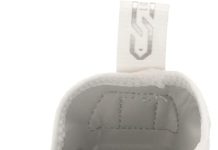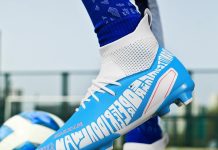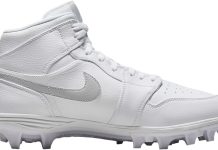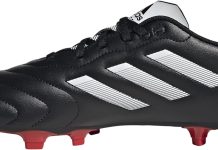Imagine stepping onto the field, feeling the rush of adrenaline, and getting ready to unleash your skills. But as you glance down at your worn-out cleats, doubt starts to creep in. Is it safe to play in old, worn-out cleats? We all know that a good pair of cleats can make all the difference in our performance on the field. In this article, we will explore the potential risks and consequences of playing in old, worn-out cleats and provide you with some valuable insights to help you make an informed decision. Whether you’re a casual soccer player or a professional athlete, it’s always important to prioritize your safety and take care of your feet.
Factors to Consider
Review contents
Condition of the Cleats
When deciding whether it is safe to play in old, worn out cleats, it is crucial to consider their condition. Inspect the cleats thoroughly for any signs of significant wear and tear, such as worn-out studs, holes in the upper material, or deteriorating seams. If the cleats are showing signs of extensive damage, it’s time to retire them to avoid any potential risks during gameplay.
Player’s Safety
The safety of the player should always be the top priority. Wearing old, worn out cleats can increase the risk of injuries. The lack of stability and reduced traction can lead to slips, falls, and even twisted ankles. It is essential to ensure that the player’s footwear provides adequate support, stability, and protection to prevent unnecessary injuries on the field.
Playing Surface Compatibility
Another crucial factor to consider is the compatibility of the cleats with the playing surface. Different sports and playing surfaces may require specific types of cleats for optimal performance and safety. For example, soccer cleats with longer studs are more suitable for playing on wet or soft grass fields, while shorter studs are more appropriate for firm ground surfaces. Using the wrong cleats on a particular surface can compromise both performance and safety.
Potential Risks
Increased Injury Risk
Playing in old, worn out cleats significantly increases the risk of injuries. As the cleats deteriorate, the necessary support and stability they provide diminish. This lack of support can lead to sprained ankles, twisted knees, or even more severe injuries. It is vital to recognize these risks and take proactive measures to avoid them.
Lack of Stability
Worn out cleats can lose their stability due to worn-down studs or weakened sole material. This lack of stability can cause players to lose their footing during quick movements or abrupt changes in direction, increasing the chances of trips, falls, and injuries. Maintaining adequate stability is crucial for players to perform at their best and minimize the risk of accidents on the field.
Foot and Ankle Problems
Old cleats that don’t provide proper support and cushioning can lead to foot and ankle problems. The lack of shock absorption can result in discomfort, blisters, or even more serious conditions such as plantar fasciitis or Achilles tendonitis. It is essential to prioritize foot and ankle health by wearing cleats that offer sufficient support and cushioning to prevent such issues from arising.
Effect on Performance
Traction and Grip
Adequate traction and grip are vital for any athlete as it affects their performance on the field. Worn out cleats can have reduced traction due to worn-down studs or improper grip patterns. This lack of traction can make it challenging to push off the ground, make quick cuts, or maintain stability, ultimately affecting an athlete’s overall performance.
Ball Control
Proper ball control is crucial in many sports, including soccer and lacrosse. Worn out cleats lacking in grip and stability can make it difficult for players to have proper control over the ball. This inability to maneuver efficiently can significantly impact a player’s performance and hinder their ability to contribute effectively to the team.
Speed and Agility
Speed and agility are essential attributes for many athletes, especially in sports like football or rugby. Worn out cleats can impede an athlete’s speed and agility due to reduced traction and stability. The loss of these critical factors can limit an athlete’s ability to move swiftly, change direction quickly, and keep up with opponents, ultimately affecting their overall performance on the field.
Alternative Options
Cleat Repair or Replacement
If the cleats are not significantly worn out and only require minor repairs, it may be possible to extend their lifespan through repairs. This could involve replacing worn-out studs or strengthening the upper material. However, if the cleats are beyond reasonable repair, it is advisable to replace them to ensure optimum safety and performance on the field.
Wearing Different Footwear
When old cleats are no longer suitable for use, athletes can consider wearing different footwear options specific to their sport. For example, athletes in sports like basketball or indoor soccer might switch to sneakers designed for indoor surfaces. This alternative option allows athletes to continue their sport while using appropriate footwear that still provides the required support and performance benefits.
Using Cleat Enhancers
If the cleats are still in relatively good condition but lack traction, cleat enhancers can be a viable solution. Cleat enhancers are add-ons that can be placed over the existing studs to provide extra grip and stability. These enhancers can improve the performance and safety of worn out cleats, making them a cost-effective alternative to immediate replacement.
Expert Recommendations
Regular Inspection and Maintenance
Experts recommend regularly inspecting cleats for signs of wear and tear. This includes checking the condition of the studs, the upper material, and the overall stability of the cleats. Performing routine maintenance, such as cleaning and tightening any loose parts, can also help prolong the lifespan of the cleats.
Replacing Cleats at Regular Intervals
To ensure optimum performance and safety, experts recommend replacing cleats at regular intervals. The recommended interval may vary depending on factors such as the frequency of use, intensity of gameplay, and the type of sport. By replacing cleats before they become excessively worn out, athletes can maintain the necessary support, stability, and performance benefits.
Choosing Reliable Brands and Models
Experts advise athletes to choose cleats from reliable brands known for their quality and durability. Investing in well-known brands ensures that athletes are getting footwear designed with performance and safety in mind. Additionally, seeking recommendations from experienced athletes or professionals in the sport can help identify the most suitable models for specific playing needs.
Considerations for Different Athletes
Age and Experience Level
When determining whether it is safe to play in old, worn out cleats, age and experience level play a crucial role. Younger athletes or those new to a sport may be more prone to injuries and may require additional support from their footwear. In contrast, older and more experienced athletes may have more developed muscle strength and stability, allowing them to tolerate older cleats to some extent.
Budget Constraints
Budget constraints can also influence the decision to continue using old, worn out cleats. While investing in new cleats is ideal for performance and safety, not all athletes or their families may have the financial means to purchase new footwear regularly. In such cases, exploring alternative options like cleat repair or using cleat enhancers may be a more cost-effective choice.
Type of Sport
Different sports have varying demands on footwear due to the playing surface and specific requirements of the sport. For example, soccer cleats are designed differently from baseball cleats to accommodate different movements and conditions. Athletes should consider the specific demands of their sport to determine whether old cleats are suitable or if alternative footwear options are necessary.
Importance of Proper Fit
Choosing the Right Size
Proper fit is essential when it comes to cleats. Ill-fitting cleats can cause discomfort, compromise performance, and increase the risk of injuries. Athletes should ensure they choose the right size by measuring their feet according to the manufacturer’s guidelines. Trying on cleats and considering any personal preferences for a snug or slightly looser fit also helps in finding the perfect cleat size.
Consideration for Orthotic Devices
Some athletes may require orthotic devices to address specific foot conditions or provide additional support. When playing in old cleats, it is crucial to consider whether these devices can still be accommodated comfortably. Ill-fitting cleats can cause discomfort when used in conjunction with orthotic devices, potentially leading to foot pain or further foot-related issues.
Wearing Appropriate Socks
The choice of socks can also impact the fit and comfort of cleats. Wearing appropriate socks, such as moisture-wicking and cushioned ones, can enhance the overall fit and feel of the cleats. Socks that are too thin or too thick may lead to discomfort and affect performance. Athletes should choose socks that provide the right balance of comfort, support, and moisture control to optimize their playing experience.
Caring for Cleats
Cleaning
Regularly cleaning cleats after each use is crucial for their longevity and performance. Remove dirt and debris from the cleats using a soft brush or cloth. For stubborn stains, mild soap and water can be used. Avoid using harsh cleaning agents or abrasive tools that can damage the material or studs.
Drying
Properly drying cleats is essential to prevent the growth of bacteria or mold. After cleaning, remove any excess moisture with a towel and leave the cleats to air dry in a well-ventilated area. Avoid using direct heat sources like heaters or dryers, as these can damage the material or cause the cleats to lose their shape.
Proper Storage
Storing cleats properly when not in use helps maintain their shape and condition. Avoid leaving them in extreme temperatures or humid environments, as these can cause damage. It is advisable to store cleats in a cool, dry place, away from direct sunlight and moisture. Using shoe bags or keeping them in a dedicated shoe compartment can also protect them from external factors.
Benefits of New Cleats
Enhanced Performance
Investing in new cleats can significantly enhance an athlete’s performance. New cleats offer improved traction, stability, and support, which translates to better overall movement and control on the field. With enhanced performance capabilities, athletes can maximize their potential and contribute more effectively to their team’s success.
Reduced Injury Risk
New cleats are designed with the latest technology and materials to prioritize safety and injury prevention. They provide proper support, stability, and shock absorption to reduce the risk of common foot and ankle injuries. By wearing new cleats, athletes can minimize the chances of sprains, strains, or other injuries, allowing them to focus on performing their best.
Increased Comfort
New cleats offer increased comfort compared to old, worn out ones. The cushioning, fit, and overall design of new cleats contribute to a more comfortable playing experience. Comfortable footwear is essential in allowing athletes to focus entirely on their performance without distractions or discomfort caused by ill-fitting or deteriorated cleats.
Conclusion
Assessing the condition of old cleats is crucial for both player safety and performance. While it may be tempting to continue using old cleats due to budget constraints or familiarity, the potential risks involved should not be ignored. Regular inspections, maintenance, and replacing cleats at regular intervals are essential practices to prioritize player safety. Investing in new cleats can not only enhance performance but also reduce injury risk and increase overall comfort. By prioritizing the condition and suitability of cleats, athletes can optimize their performance on the field and ensure a safe and enjoyable playing experience.





